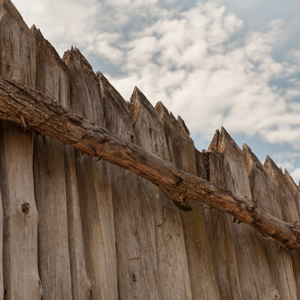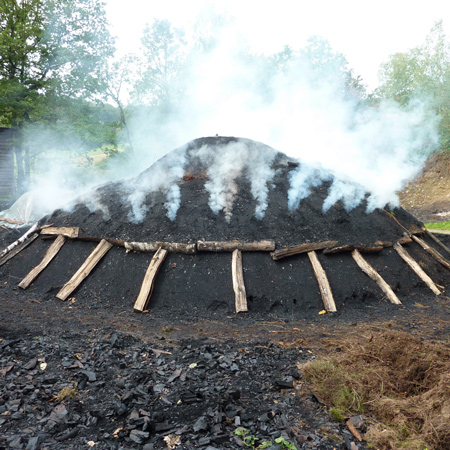Posecopsahe was the chief of Ruptáre, the “Second Village” of Mandans at the Knife River Villages. The captains designated him “Black Cat Grand Chief of the Mandans.” The latter name was derived from the Mandan púskapsi probably meaning in this context, black panther or mountain lion.[1]Clay S. Jenkinson, A Vast and Open Plain: The Writings of the Lewis and Clark Expedition in North Dakota, 1804–1806 (Bismarck, North Dakota: State Historical Society of North Dakota, 2003), 68n103.
In response to the captains’ requests for a Mandan-Arikara peace agreement, exclusive trade with St. Louis, and a Mandan delegation to visit Washington City, Posecopsahe initially gave favorable responses. Throughout the long winter, however, he would have to tell the captains that he could not fulfill their wishes. On 18 November 1804, Black Cat brought news that they would continue trading with the English companies to the north. In April 1805, he withdrew from the Washington City delegation and any Arikara alliance citing interference from the Lakota Sioux.
Despite the bad news brought by Posecopsahe during the winter at Fort Mandan, Lewis’s opinion of him was high:
[8 February 1805]
this man possesses more integrety, firmness, inteligence and perspicuety of mind than any indian I have met with in this quarter, and I think with a little management he may be made a usefull agent in furthering the views of our government.
Selected Encounters
October 28, 1804
Curiosity and corn


At camp across from the Knife River, Hidatsas and Mandans bring gifts of corn and curiosity about York. Posecopsahe (Black Cat), Clark, and Lewis look for a place to build winter quarters.
October 31, 1804
Black Cat speaks


Clark visits Posecopsahe (Black Cat), the main chief at Ruptáre, one of the five Knife River Villages. Posecopsahe wishes for peace and returns two beaver traps recently stolen from two French traders.
November 18, 1804
Blackcat visits


At Fort Mandan, Black Cat’s wife brings as much corn as she can carry. Blackcat tells the captains that the Mandans have decided to continue with the Canada-based traders rather than St. Louis.
November 22, 1804
Domestic violence


A Mandan man threatens to kill his wife for having slept with Sgt. Ordway. Clark orders the sergeant to give the man some trade goods. Twelve bushels of corn—still on the cob—is brought in.
November 28, 1804
Black Cat's medals


On this snowy day at Fort Mandan, Posecopsahe—Black Cat—comes to see the American “Curiossities.” He is told to no longer accept peace medals or flags from trader François-Antoine Larocque.
December 4, 1804
Jusseaume's discontent


At Fort Mandan, the main bastion is completed. Posecopsahe (Black Cat) and two chiefs visit, and Clark reports that interpreter René Jusseaume is assuming and discontented.
December 11, 1804
Sun dogs


At Fort Mandan below the Knife River Villages, rings appear around the sun when its light hits ice crystals suspended in the air. Due to the cold, Clark orders all the hunters to return to the fort.
January 2, 1805
A frolic at Ruptáre


On this snowy day, Lewis takes a large group to Black Cat’s village—Ruptáre, and New Year’s celebrations continue. At Fort Mandan, several Knife River villagers bring corn to pay the blacksmiths.
January 11, 1805
War medicine dance


Posecopsahe (Black Cat) of Ruptáre and The Coal of Mitutanka visit Fort Mandan and spend the night. At Mitutanka village, several soldiers witness a war medicine dance—perhaps the Mandan Wolf Ceremony.
February 8, 1805
Wolves and Ravens


At Fort Mandan, Lewis entertains Posecopsahe (Black Cat) and his wife. Away from the Knife River Villages, Clark has a pen built to keep the wolves and ravens away from the harvest of the hunt.
February 13, 1805
Clark returns


Clark returns to Fort Mandan during the night and today, records the events of his nine-day-long hunting trip. Mandan chief Posecopsahe (Black Cat) is given a war axe and appears ‘much gratified’.
March 3, 1805
All hands employed


At Fort Mandan, the captains receive Mandan and Hidatsa visitors. The enlisted men make charcoal, braid a tow-line rope, and away from the fort, a detachment carves dugout canoes from cottonwood logs.
April 8, 1805
A swamped canoe


After leaving the Knife River Villages, one of the dugout canoes fills with water wetting a wooden keg of gunpowder. Below present Garrison Dam in North Dakota, headwinds force them to stop for the day.
August 14, 1806
Among old friends


The expedition arrives at the Knife River Villages—one of which is the home of the Charbonneau family. The captains meet with various chiefs, and Clark invites them to travel to Washington City.
Notes
| ↑1 | Clay S. Jenkinson, A Vast and Open Plain: The Writings of the Lewis and Clark Expedition in North Dakota, 1804–1806 (Bismarck, North Dakota: State Historical Society of North Dakota, 2003), 68n103. |
|---|
Experience the Lewis and Clark Trail
The Lewis and Clark Trail Experience—our sister site at lewisandclark.travel—connects the world to people and places on the Lewis and Clark Trail.
Discover More
- The Lewis and Clark Expedition: Day by Day by Gary E. Moulton (University of Nebraska Press, 2018). The story in prose, 14 May 1804–23 September 1806.
- The Lewis and Clark Journals: An American Epic of Discovery (abridged) by Gary E. Moulton (University of Nebraska Press, 2003). Selected journal excerpts, 14 May 1804–23 September 1806.
- The Lewis and Clark Journals. by Gary E. Moulton (University of Nebraska Press, 1983–2001). The complete story in 13 volumes.

